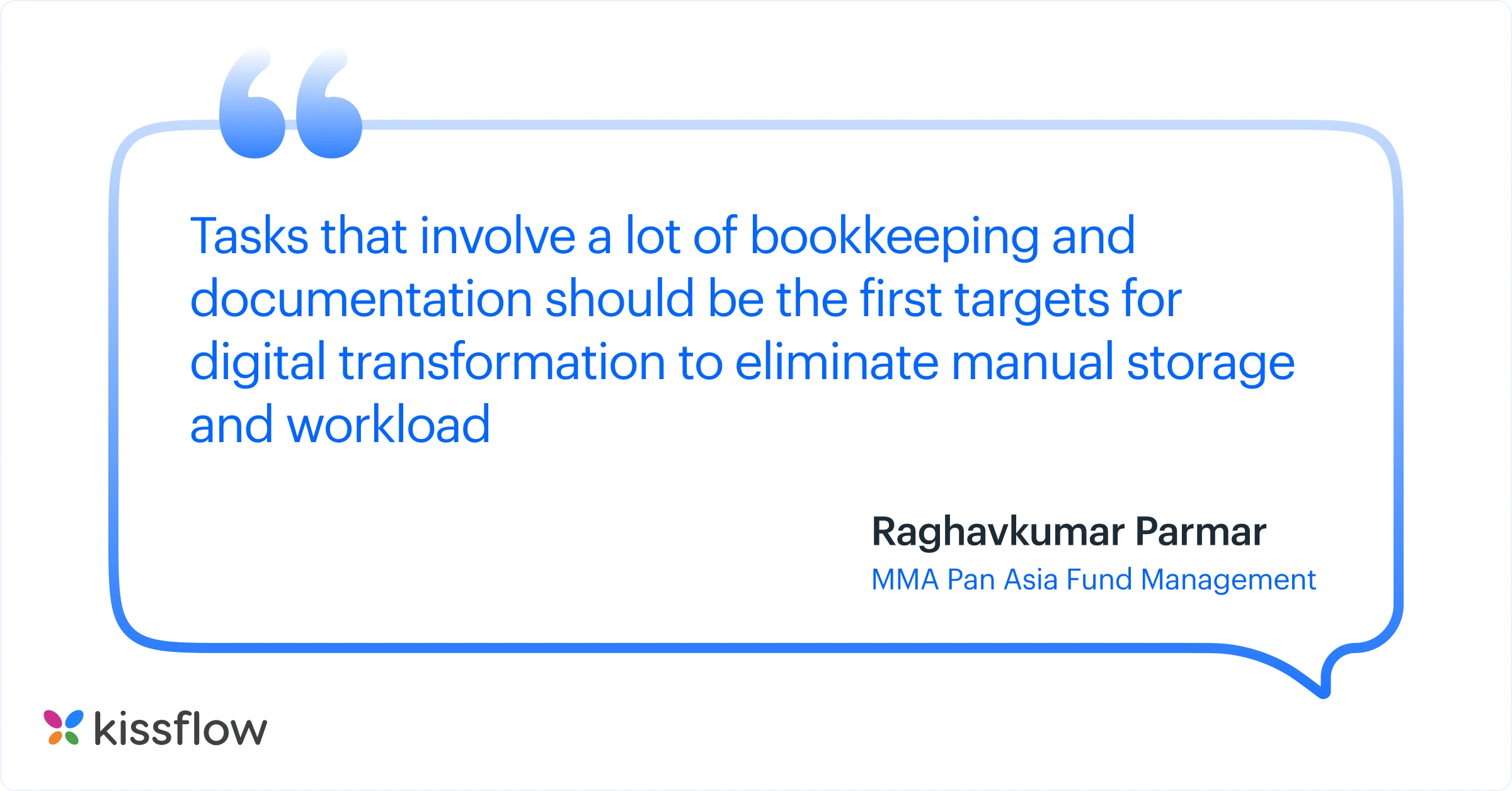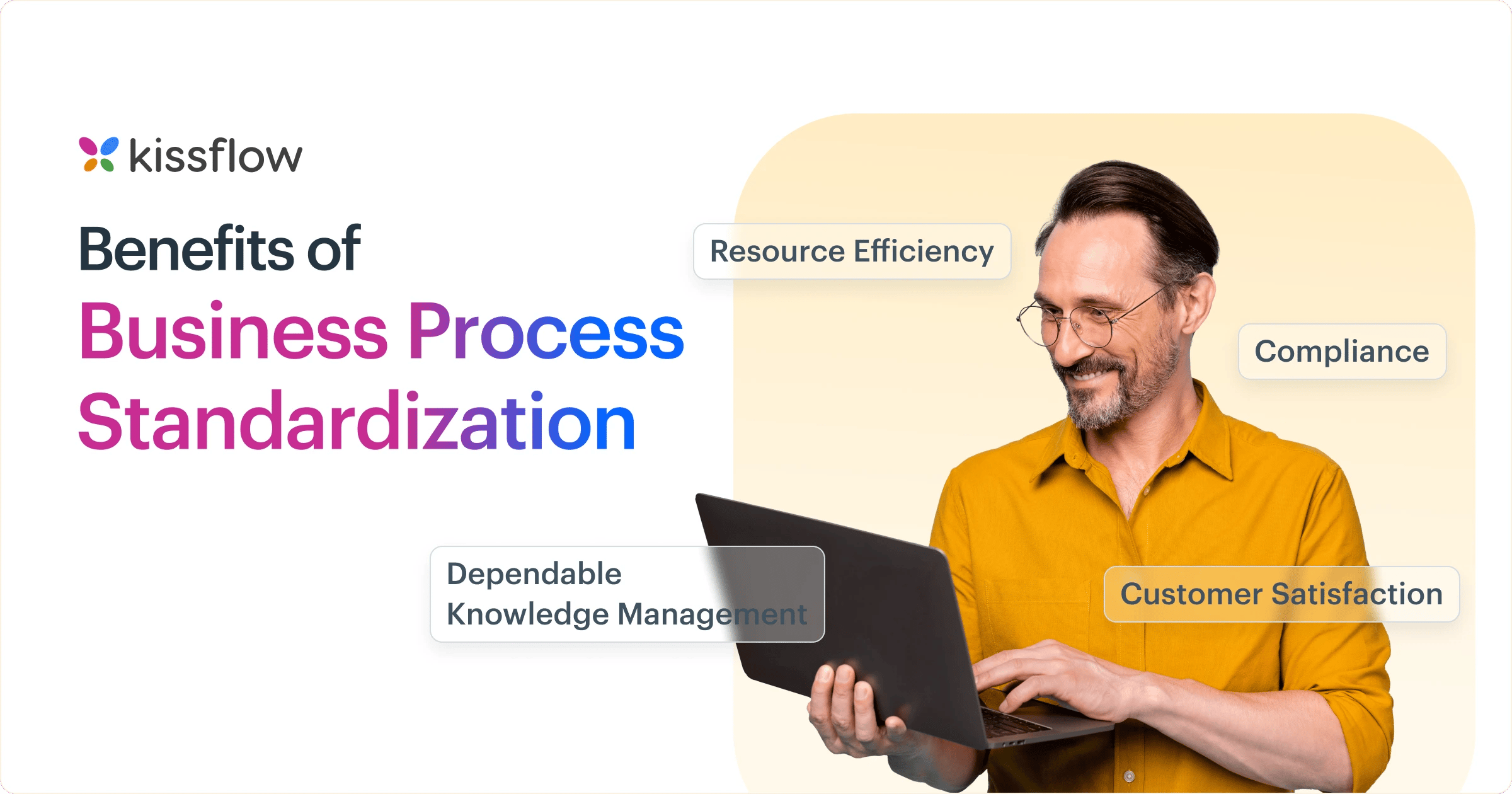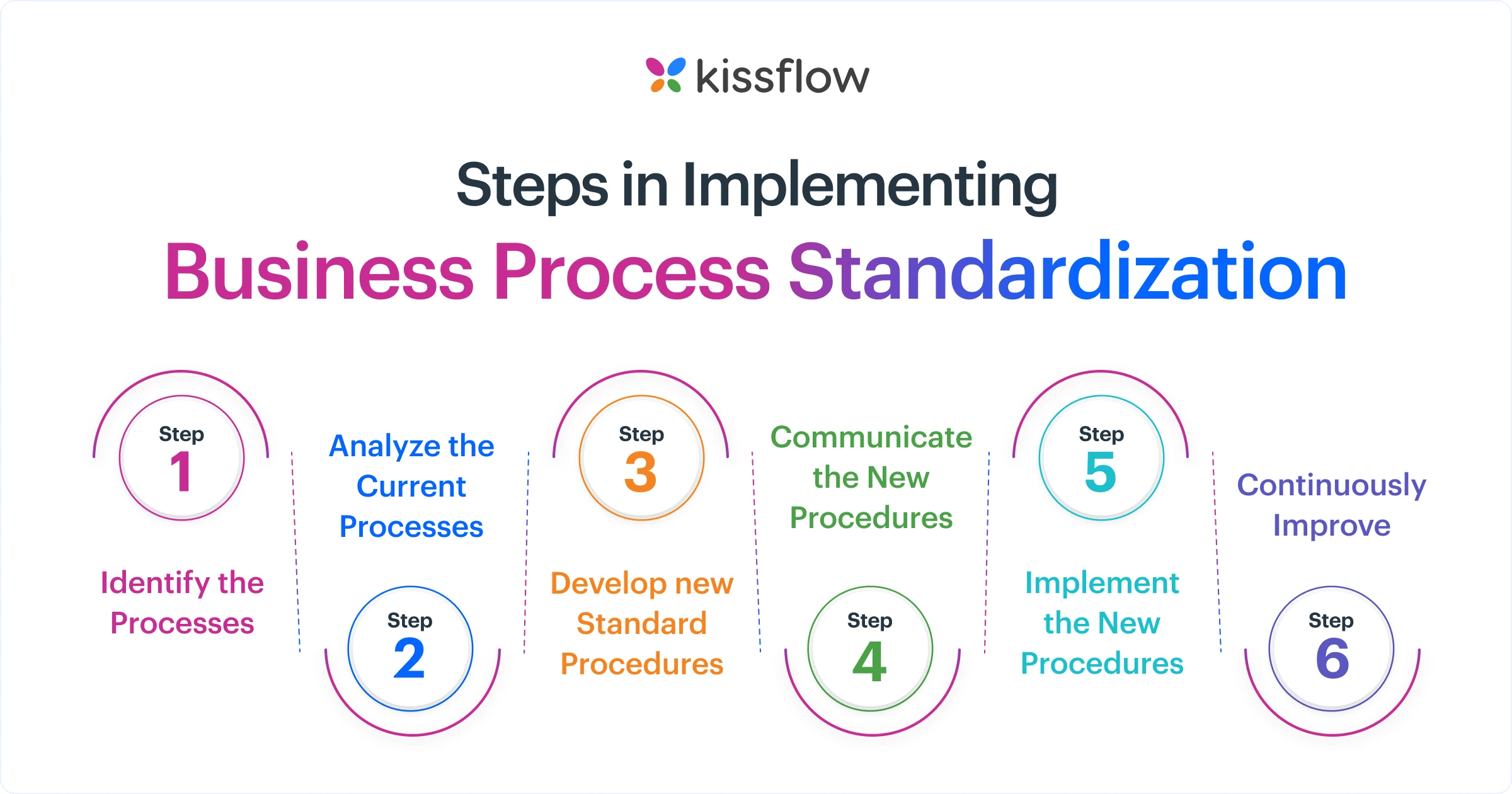
- >
- BPM Software >
- Your Guide to Understanding Business Process Standardization
Your Guide to Understanding Business Process Standardization
Streamlined business processes are the cornerstone of every successful enterprise. They form the blueprint for internal operations and enable the otherwise disparate parts of the company to work together.
But as many departments and teams develop business processes in isolation, it can lead to disjointed processes and silos across the organization.
For CIOs who want to streamline operations and achieve digital transformation, establishing a business process standardization through a unified solution is necessary.
Business process standardization aims to reduce trial and error and the waste associated with solving problems from scratch. With a singular solution model, it’s easy to scale results with certainty and get more done with fewer resources.
Let’s look into the essence of business process standardization, why it matters to your business, and how you can start standardizing processes for increased production efficiency.
What is Business Process Standardization?
Business Process Standardization also known as Business Process Management (BPM) Standards refers to the creation of a uniform method that an organization can adopt to carry out tasks or activities across various departments and branches.
Business process standardization aims to:
- Identify the numerous, scattered ways a specific problem is solved across an organization
- Work out a unified solution to that problem
- Implement that singular solution across the entire organization
The aim of business process standardization is to reduce trial and error and the waste associated with solving problems from scratch. With a singular solution model, it’s easy to scale results with certainty and get more done with less resources.
In this article, we look into the essence of business process standardization, why it matters to your business, and how you can get started standardizing processes for increased production efficiency.
How Does Business Process Standardization Work?
Compartmentalization is a key concept that makes business process standardization work.
It is simply perfecting a solution in a way it can be copied and applied wherever it’s needed.
This creates a solution that can easily be copied, just like a widget, and slotted into whatever part of the organization it’s needed.
Business process componentization helps organizations do more with less since now, they can focus on perfecting one system and deploying it at scale to solve the same need wherever it appears across the organization.
Why Does Business Process Standardization Matter?

The very essence of business process standardization is in its name.
Standardization.
Business process standardization creates a uniform, repeatable blueprint for getting a task done so that whenever it comes up—at whatever department or stage of the organization’s operations—that task can be easily carried out with minimal ambiguity.
BPS creates a standard and a culture of certainty and removes the trial and error curve so the entire organization can get repeatable tasks done with little or no friction.

Unlock the Power of Comprehensive BPM Tools: Scale, Succeed, and Stay Ahead
Thank you for downloading!
How to Standardize Business Processes
Business process standardization is a two-step process that typically involves:
- Identifying the best process possible for achieving an outcome. This involves analyzing duplicates of an existing process across an organization and working out a singular solution that helps achieve your goals faster and more efficiently, and,
- Implementing the best process across all instances in an organization where it’s needed.
Put together, the process discovery and implementation elements help teams develop an ideal process structure that can then be scaled up to the entire organization.
1. Business process discovery
At the process discovery stage, the process management team identifies:
- All instances across the organization where a specified task is being carried out,
- The different process configurations used for carrying out the task mentioned above and,
- Opportunities for uniting the different process configurations into one.
With an overview of the different process configurations used to achieve the same outcome across the organization, the team can begin working to create a unified process outline for use across any instance of that task. Leveraging BPM tools facilitates this standardization by enabling teams to map, analyze, and optimize workflows, ensuring consistency and efficiency throughout the organization.
Here, you can use a pen and paper to craft how your new, improved process will look manually, but… good luck getting anywhere when you make a mistake and decide to rub it out.
On the other hand, you could use a tool like Kissflow instead.
Kissflow offers a simple workflow management tool smart companies use to plan unified processes. With Kissflow, you can:
- Visually outline processes step-by-step,
- Invite team members to collaborate virtually—instead of handing out printed sheets, and,
- Manage these processes across your entire organization—all from one easy-to-use interface.
Kissflows simplifies workflows and processes, so your team can spend less time resolving process chaos and more time doing their best work with them.
2. Process Implementation
Process implementation involves:
- Informing relevant staff of the changes to the processes they’ll be working with so they can observe the changes
- Requiring relevant team members and staff to apply the improved processes and above all
- Building a culture of incremental improvement to the processes used across your organization
Benefits of Business Process Standardization

Business process standardization takes the best way of producing goods or delivering services, making it the standard across the entire organization. As explained in the Younium revenue recognition for SaaS guide, these solutions can also offer a way to track and manage subscriptions in a way that’s compliant with revenue recognition standards. As a result, change can be created easily and quickly and duplicated across the different levels of the organization where such a need comes up.
Here are the top 4 benefits of business process standardization.
1. Improved Customer Satisfaction
To a great degree, customer satisfaction is always a prime objective in every organization. This is because when customers’ needs are met, their business generates revenue that keeps the company profitable.
Business process standardization takes the best way of producing goods or delivering services, making it the standard across the entire organization. As a result, customers are guaranteed a specific product or service quality, which keeps them delighted and returning.
2. Compliance
With one way of getting a specific task done wherever it shows up, it’s guaranteed that once a change is made, it affects every part of the organization where that task shows up.
The team can, therefore, be sure that any policies or regulations adopted are going to be fully adhered to across the entire organization, hence ensuring they’re compliant to applicable rules and regulations.
3. Resource Efficiency
Business process standardization not only seeks a uniform process for carrying out tasks. It’s also geared towards getting these tasks carried out with as few resources as possible.
This leads to a scenario where resource savings in one branch of an organization are easily and quickly duplicated, multiplying the cost savings many times over.
4. Dependable Knowledge Management
Business process standardization helps an organization create one source of truth for getting tasks done. This results in a situation where notes and best practices derived from one place where a process is applied can be applied several times over without having to be created from afresh.
What is the difference between business process standardization and integration?
Business process standardization sets specific standards for creating and managing a single business process. The goal is to ensure every team member manages business processes in the same way.
Business process integration allows enterprises to connect their data, processes, applications, and people through a business process management platform designed to streamline their internal operations.
Example of business process standardization: Streamlining customer service
Without standardization, the customer service process can be fragmented, with every team using different tools and processes to manage incoming customer issues and inquiries. The lack of standardization can lead to longer response times and inconsistent customer experience.
Business process standardization can help establish a consistent ticket creation, categorization, prioritization, and resolution process. It can centralize all customer inquiries, streamline the ticketing system, improve response times, and enhance overall customer satisfaction.
Steps Involved in Implementing Business Process Standardization

Following are the steps involved in implementing business process standardization
1. Identify the Processes that Need to be Standardized
This can be done through a process mapping exercise or by surveying employees.
2. Analyze the Current Processes
Identify the variations, inefficiencies, and bottlenecks in the current procedures.
3. Develop new Standard Procedures
Use the information gathered in the previous steps to develop new procedures that are efficient, consistent, and easy to follow.
4. Communicate the New Procedures
Inform all employees of the new procedures and provide training if necessary.
5. Implement the New Procedures
Roll out the new procedures to all employees and monitor their adherence.
6. Continuously Improve
Regularly review and update the procedures to ensure they are still efficient and effective.
Achieve process standardization with Kissflow
Business process standardization offers every forward-thinking organization an avenue of taming process chaos and getting more done with a fixed standard.
It minimizes resource waste, increases production certainty, streamlines business processes, and makes it easier to manage similar processes at scale and still be sure of quality. With business automation software, companies can unify fragmented processes, eliminate redundancies, and ensure consistent execution across departments. This creates a foundation for scalable operations and better decision-making at every level.
Solve your workflow challenges with Kissflow and optimize your team's productivity.
Frequently Asked Questions:
1. What are the benefits of business process standardization?
Business process standardization benefits include consistent quality regardless of who performs the task, easier employee training and onboarding, improved efficiency through elimination of redundant approaches, better measurement and comparison across locations, stronger compliance controls, simplified automation implementation, reduced operational risks, and clearer accountability for outcomes.
2. How does standardization improve workflow efficiency?
Standardization improves workflow efficiency by eliminating variations that cause confusion and errors, reducing decision time through clear guidelines, simplifying training for new employees, creating predictable outcomes regardless of who performs the task, establishing clear measurement criteria, facilitating easier automation of consistent processes, and enabling meaningful comparisons between different business units or time periods.
3. What industries prioritize process standardization?
Industries prioritizing process standardization include manufacturing seeking consistent quality outputs, financial services ensuring regulatory compliance, healthcare standardizing clinical protocols, franchising businesses maintaining brand consistency, multinational corporations aligning global operations, and government agencies harmonizing citizen services. Organizations with distributed operations or high compliance requirements gain the most value.
4. What are the challenges in standardizing business processes?
Challenges in standardizing business processes include resistance to change from employees accustomed to current methods, difficulty balancing standardization with necessary local variations, insufficient executive sponsorship, inadequate training and documentation, legacy system limitations, lack of clear process ownership, difficulty measuring standardization benefits, and challenges maintaining standards over time as businesses evolve.
5. What tools help implement business process standardization?
Tools that help implement business process standardization include process documentation platforms creating clear guidelines, workflow management systems enforcing standard procedures, knowledge management repositories sharing best practices, training and certification systems ensuring competency, process mining discovering variations, governance frameworks establishing ownership, collaboration tools facilitating consensus building, and performance dashboards tracking adherence to standards.
Related Articles











